I was recently told that my top-of-the-line MB Quart headphones would probably sound better (because of my Sony receiver's weak headphone amp) if I wired a 1/4" female headphone jack to the 'B' left and right outputs of my reciever. Apparently the ohm load the headphones put on the amp lowers it's output significantly and will not damage them, and the perceived output relative to the volume knob will be pretty close to how it is using the headphone jack.
Is this fact or fiction??
Is this fact or fiction??
I can't really answer your question but Rod Elliot's Headphone Adaptor for Power Amplifiers may shed some clues.
Normally, headphone outputs are taken right from the speaker output circuits on an amplifier, with 220-330 ohm resistors in series with them. Without the resistors the volume control is really touchy, since they need very little voltage to operate.
Headphone impedances range from 32 to 300 ohms nowadays. The series resistor may be different for optimum volume control resolution with different impedances.
Whether it'll sound any better than through the headphone jack you have? Just gotta try it and see.
Headphone impedances range from 32 to 300 ohms nowadays. The series resistor may be different for optimum volume control resolution with different impedances.
Whether it'll sound any better than through the headphone jack you have? Just gotta try it and see.
These are 300 ohms per side, would any resistors really be necessary? I tried to run it the way that picture shows, but without the resistors, but there was a short somewhere. The volume was about what I would expect with the knob at that position if I were using using the headphone jacks, but there was a short somewhere in my solder connections (I knew it was a short because one side was louder than the other) and after about 5 or 6 seconds the amp went into protect mode.
Why not just build yourself a dedicated headphone amplifier? There's a bunch of them to choose from on the projects page over at http://www.headwize.com.
se
se
And destroyer was thinking a lot!
This way i burn the last "neuronium" i had to use.
You near to turn crazy!..... if you found a completely flat audio point inside your amplifier..... put their an good capacitor... two for stereo of course..... ihhhhhh!....my last neuronium is almost dead!!!...... lets run fast till he died!..... and construct an small class A amplifier that uses batteries and the headphone voice coil connected in series with the colector.....put also an emitter resistor, this way if your transistor became shorted (very difficult to happen that) the amount of current will not burn your headphone.... this way..... "a direct drive, flat, and class A amplifier in a very good headphone" will send you to heaven.... the quality you will hear will make you trow your speaker out off the window and to saw you big and complicated amplifier or to use it as a heater generator to cold mornings!
This way you be thinking why so big technologies..... why so big expenses of money..... why so much power?....... that's all those things will appear stupid for you and you will became a sad and unhappy person...
I think............ aaaaah!...... its burning last functional 52 years old last neuronium!.......better not do do!......you will look to yourself in the mirror and will think that's a crazy world!
Carlos, the destroyer X likes you
This way i burn the last "neuronium" i had to use.
You near to turn crazy!..... if you found a completely flat audio point inside your amplifier..... put their an good capacitor... two for stereo of course..... ihhhhhh!....my last neuronium is almost dead!!!...... lets run fast till he died!..... and construct an small class A amplifier that uses batteries and the headphone voice coil connected in series with the colector.....put also an emitter resistor, this way if your transistor became shorted (very difficult to happen that) the amount of current will not burn your headphone.... this way..... "a direct drive, flat, and class A amplifier in a very good headphone" will send you to heaven.... the quality you will hear will make you trow your speaker out off the window and to saw you big and complicated amplifier or to use it as a heater generator to cold mornings!
This way you be thinking why so big technologies..... why so big expenses of money..... why so much power?....... that's all those things will appear stupid for you and you will became a sad and unhappy person...
I think............ aaaaah!...... its burning last functional 52 years old last neuronium!.......better not do do!......you will look to yourself in the mirror and will think that's a crazy world!
Carlos, the destroyer X likes you
peranders said:I think the best solution is to have a separate headphone amp with low gain, low noise, low distortion, low everything. In some cases you can connect the headphones directly to line out if the headhone has rather high impedance and/or the output has good drive capability.
Yup. And outputs that don't have the drive can be bolstered with a very simple buffer. Also, I'm looking into a passive solution using a 4:1 line level output transformer for outputs that have plenty of voltage gain and output voltage swing but insufficient current capabilities.
se
The Paulinator said:These are 300 ohms per side, would any resistors really be necessary? I tried to run it the way that picture shows, but without the resistors, but there was a short somewhere. The volume was about what I would expect with the knob at that position if I were using using the headphone jacks, but there was a short somewhere in my solder connections (I knew it was a short because one side was louder than the other) and after about 5 or 6 seconds the amp went into protect mode.
Let's say that your amplifier puts out about 50W in 8 ohm impedance, with a voltage swing of 20V or something. For the headphones, you need around 0.15W to max 0.5W if they are really low sensitivity (and you feel the need to melt both the headphones and your ear wax), in 300R impedance, with a much lower voltage. Thus the resistors in the image.
Get the resistors (you might get away with 5W white ones & they're cheap), get 4 banana plugs for speakers, get a female 3.5mm jack, get 1m of microphone cable instead of 4wire shielded, cut that in half, make the connections as in the pic using one wire instead of two, make sure you take in account ground (red) & hot (black) from the amp, check everything THRICE, & only then plug it in (with the amp off). Use (electrical black duct tape)? to insulate everything that is hanging around and could touch anything.
Turn the amp on, take a cheap pair of cans, check the adapter, only AFTER that plug in your expensive set.
DO NOT experiment with your good set of cans; do it only until after you know what you're doing. The amp has protection, that's a good thing but don't play with the cans doing twisted connections that might slip and get your wallet thinner in seconds.
150 mw into 300 ohms is about the same voltage as 5 watts into 8 ohms. Without limiting resistors your volume control will be at the 1-2 watt level... whatever that is for your amp.
Personally I don't see a point in building a separate headphone amp unless you feel the need for a DIY project. I'd put 1000 ohm 1/2 watt resistors in series with the headphones and see how it sounds. Crank it up slowly...
Personally I don't see a point in building a separate headphone amp unless you feel the need for a DIY project. I'd put 1000 ohm 1/2 watt resistors in series with the headphones and see how it sounds. Crank it up slowly...
Years ago I connected some high impedance low sensitivity
Yamaha "isodynamic" heaphones directly to the output of
a NAD3020 amplifier without any problems whatsoever.
However if you do not have volume issues, you will have
noise issues with direct connection. If you want low
impedance drive for your phones it would be best to
connnect them via step down transformers to the amp,
or use a dedicated low impedance headphone amplifier.
 sreten.
sreten.
Yamaha "isodynamic" heaphones directly to the output of
a NAD3020 amplifier without any problems whatsoever.
However if you do not have volume issues, you will have
noise issues with direct connection. If you want low
impedance drive for your phones it would be best to
connnect them via step down transformers to the amp,
or use a dedicated low impedance headphone amplifier.
maylar said:I'd put 1000 ohm 1/2 watt resistors in series with the headphones and see how it sounds. Crank it up slowly...
Most amps already have resistors (680R or so) in series on their headphone outputs so no need to do that
The thing here is to keep a low output impedance, that's why I brought up that specific adapter.
- Status
- This old topic is closed. If you want to reopen this topic, contact a moderator using the "Report Post" button.
- Home
- Amplifiers
- Solid State
- Ok to run high-end headphones with amp output?

